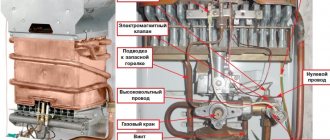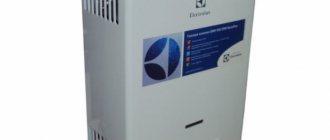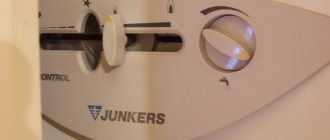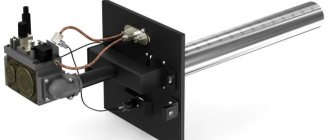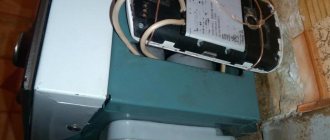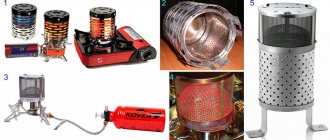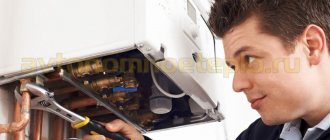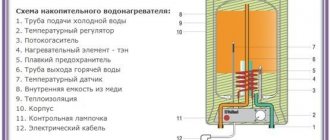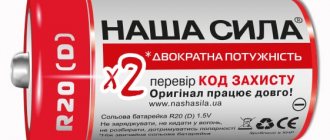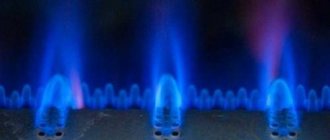Differences between a turbocharged and a classic column
The main difference between a gas water heater with forced exhaust is the design of the closed combustion chamber. Air and combustion products are removed not through natural means, but through a working fan.
Installing such a water heater is beneficial in houses where there are no chimney ducts. This is due to the operating principle. An ordinary gas water heater discharges combustion products onto the street through a classic chimney. The combustion products of a turbocharged water heater are discharged similarly to the street only through a coaxial pipe led horizontally through the wall.
For a turbocharged water heater, it is allowed to install a vertical chimney from a coaxial pipe.
The turbocharged gas instantaneous water heater has the following design features:
- Air is sucked in and combustion products are removed through a coaxial chimney that goes outside. For easy understanding, this is a double-walled pipe that forms channels.
- The turbocharged column is equipped with a modulation burner, which can operate in a smooth mode, changing the heating intensity.
- The devices do not have automatic ignition from batteries, a piezoelectric element with a manual start button, or an igniter with a constantly burning flame.
- The turbo gas water heater operates fully automatically without human intervention.
- Air pressure and gas supply are regulated by the controller. The electronic unit automatically sets the optimal fuel mixture ratio.
- A turbocharged water heating device operates from an electrical connection.
A gas flueless water heater can have two types of auto-ignition: spark electrodes or a hydrogenerator.
The turbocharged system has turned an ordinary gas water heater into an economical and safe water heater.
Principles for selecting a turbo dispenser
Selection of a turbo heater
The range of gas water heaters with turbo mode on the Russian market is frankly small. For many years, one model from Bosch dominated, which was frankly not the best in its mechanical characteristics, a little later an option from Ariston of the “Marco Polo” series was added, both options were practically the only choice in the CIS.
Now the situation has leveled out somewhat, but below we will consider turbocharged speakers from different manufacturers en masse. This is due to the fact that even in 2021, only the largest manufacturers have a full line of heaters with a closed chamber.
The second reason, as already mentioned, lies in the fairly high price. We neglect everything that is more expensive than a thousand dollars (Bosch, for example, has several models that are much more expensive). From a practicality point of view and taking into account the Russian climate, it is better to buy a double-circuit boiler with a heating function for almost the same amount, and the lack of waiting for heating is more than compensated by the possibility of using full-fledged independent heating.
Water heating systems based on the combustion of hydrocarbons depend primarily on the pressure of the gas mixture. If we are talking about a propane-butane system powered from a cylinder, an appropriate reducer is usually installed. Turbocharged dispensers with the ability to connect cylinders are marked separately. If the water dispenser is traditionally connected to the gas main, then the end user has no influence on anything in this regard.
The second necessary parameter is water pressure. In most of our systems, according to all standards, it is within 0.15 bar. But in the event of a serious gust, the design of the speakers usually includes the ability to survive a water hammer with a force of up to 12-15 bar.
It should be noted that geysers of turbo systems often become victims of the “advanced” system. In cases of “intelligent” flame control, a sensor can be installed to monitor the water pressure and adjust the burner accordingly. The problem is that such sensors in many mid-price models are incredibly capricious, which is why either an icy stream or hot boiling water periodically flows from the column.
The performance of the column is calculated by how many liters are heated per minute. In the case of turbocharged dispensers, this parameter directly depends solely on the power of the blower, which provides the flow, because the diameters of the supply pipes are standardized. The recommended performance of the column for various household needs can be briefly described by the following diagram:
Column diagram
On average, it is assumed that one water supply point is a mixer, which consumes about 7 liters of water per minute. The picture as a whole is universal for both simple open-chamber speakers and turbo systems.
The issue of igniting the device is resolved relatively simply. Any water heating equipment can be started in the following ways:
- manually, with open fire, primarily with matches. The simplest option, but it is also the most fire hazardous. In addition, the mechanical structure breaks down;
- piezoelectric element, activated by a separate button.
- Electric ignition. The best possible option.
Turbocharged speakers use the latter option.
Advice. All other things being equal, choose a simpler design. If there is no significant increase in performance and smoothness of heating control, there is little point in additional sensors, they cost a large amount, and the fault tolerance is much lower. There are also very reliable technically advanced models, but they are much more expensive.
Types of turbocharged water heating devices
Geysers with turbo exhaust are divided into two types:
- Semi-turbo gas water heaters are limited in use, since they are exhausted on one side. The fan does not force fresh air from outside into the combustion chamber, but only removes combustion products. Air intake occurs naturally. The semi-turbinated column is capable of operating in a room with a ventilation system. If natural air exchange is far from standard values, the gas appliance cannot be used.
The advantage of semi-turbo water heaters is their low cost. The price is almost half that of turbocharged models.
- A turbocharged gas water heater is equipped with forced exhaust and pressurization, so room ventilation is not important for the device. It may be completely absent. The fan removes combustion products to the street through the internal channel of the coaxial pipe. The external passage forces forced suction of fresh air into the combustion chamber.
The advantage of a turbine column is its safe use. A gas water heater is installed inside any room, regardless of the presence of ventilation.
The difference between the two types also lies in the combustion chamber. Only for turbocharged heaters it is of a closed type. Semi-turbo models are equipped with an open chamber, since air intake is carried out through natural circulation.
Design and principle of operation
The basic structure of all geysers is the same. A flow-through heater consists of a housing, a water and gas unit, a heat exchanger, a combustion chamber, sensors, a control unit, and a chimney. For turbocharged devices, only a fan is added. The general principle of operation is also the same: water extraction begins - the burner lights up, the water tap is closed - the flame goes out.
If we go into the nuances of the operation of a turbine column, they are very different from the functionality of a traditional device:
- While there is no water analysis, air is not forced into the closed combustion chamber. The pilot light does not light because it is missing.
- When water collection begins, the water and gas unit is activated. The mechanism opens the valve through which gas enters the burner. The controller gives a command for electrical ignition and a spark appears on the electrodes. The sensor informs about the appearance of a flame on the burner. It gives a signal to the controller to stop sparking.
- When the column is ignited, the fan turns on. It begins to pump air from the street into the chamber and at the same time remove combustion products through a coaxial chimney.
- The water is heated to the set temperature. This indicator is monitored by a sensor connected to the controller. With an increase or decrease in water flow, the modulating burner switches combustion intensity levels, thereby maintaining the set temperature.
- As soon as the water flow stops, the burner and fan turn off. The speaker goes into standby mode.
With the start of a new water collection, the entire cycle repeats.
Efficiency of a turbocharged water heater
A fan installed in a gas water heater, a modular burner and a double-walled coaxial chimney can increase efficiency up to 90%. The column developers managed to achieve the efficiency of the device due to three parameters:
- the fuel mixture is prepared from a precise ratio of gas to air;
- stepwise combustion adjustment saves gas, preventing overheating of water with little analysis;
- Inside the coaxial pipe, preheating of the incoming air flow occurs.
The increase in efficiency is more influenced by the third parameter. The air entering from the street warms up against the walls of the coaxial chimney. Cold does not get inside the chamber, due to which less gas is spent heating the water in the heat exchanger.
Safety stages of a chimneyless dispenser
When considering the operation of a water heater with a turbo hood, it is worth paying attention to the safety levels. The protection is triggered according to the following parameters:
- there is no draft in the hood due to the fan stopping;
- the flame on the burner has disappeared;
- high or low gas pressure in the supply pipeline;
- low or high pressure in the water supply;
- heating the heat exchanger to a critical temperature;
- low water consumption;
- controller failure.
If one of the problems occurs, the operation of the geyser will stop.
There are models of columns in which the fan continues to operate after the flame on the burner goes out. This doesn't happen for long. The fan will cool the heat exchanger and then turn off.
Advantages and disadvantages
To get a complete picture of the device, it is worth considering the advantages of turbocharged geysers over classic devices:
- Air forced by a fan allows the water heater to operate indoors without ventilation. The air masses entering the combustion chamber are preheated against the walls of the coaxial chimney, due to which the efficiency increases.
- The closed chamber does not transfer heat into the room, which is important in the summer on hot days.
- Oxygen in the room is not burned out due to the injection of air from the street.
- Combustion products do not enter the room from the closed chamber. The possibility of gas contamination is excluded.
A person purchasing a speaker should know the disadvantages of a turbocharged device:
- A turbocharged gas water heater is volatile. Without voltage, the fan and electric ignition do not work. To use the device during a power outage, you will have to additionally install an uninterruptible power supply.
- The blades and electric motor of a running fan create specific noise in the room.
- The cost of the device is high. The cheapest model will cost at least 15 thousand rubles.
- Before installing the column, you will need to obtain permission from the gas service.
There is another nuance to using a gas appliance, related to neighbors living on the floor above. The fan creates a discharge flow of combustion products that penetrate through open windows into the neighboring apartment. Before installing the column, this issue requires approval.
Criterias of choice
To make the right choice of model, you need to study the device parameters and take into account important installation nuances:
- First, they decide on the place where the water heater will be installed. Based on the location in the room, it is easier to determine the dimensions of the device, as well as calculate the cost of purchasing additional materials for installation, such as pipes for exhaust and water.
- Burner power is the first parameter that requires attention when choosing a column. For domestic use, models with an average rating are suitable, capable of providing hot water to 1–2 points. If analysis is carried out simultaneously from 3-4 points, you will need a device with a higher power burner.
- The performance of a gas water heater is determined by the consumption of hot water. The optimal rate is in the range of 10–11 l/min.
- The automatic water heater has a threshold for maximum and minimum water pressure in the water supply. If these values do not match, the column simply will not turn on.
- Most water heaters are designed to be connected to a centralized mains, but there are water heaters that run on bottled liquefied gas.
- They choose a speaker not because of the popularity of the manufacturer, but by the availability of spare parts and their cost. There is no such water heater that will constantly work without repair.
Modern manufacturers are trying to equip their products with additional functions. Most of them are unnecessary, and you shouldn't overpay. There is a competent opinion: the more a device is endowed with additional functions, the more capricious it works and the more expensive it is to repair.
Popular models
We took 4 models as an example. Three of them are within 10,000 rubles.
Ariston MARCO POLO GI7S 11L FFI
This is an economical turbocharged flow-type model. The new generation version is different:
- stylish design;
- touch screen;
- multi-stage security system;
- stable operation at reduced pressure.
Features of the Ariston Marco Polo model:
- electronic ignition;
- power modulation;
- stability of heating due to microprocessor control;
- temperature display on a digital indicator;
- self-diagnosis function;
- any type of gas can be used as fuel;
- compactness;
- stainless steel housing;
- push-button control panel and LCD screen.
This exhaust-free version is adapted to Russian operating conditions. Warranty - 2 years. Approximate price - 17,000 rubles.
Technical specifications:
| Thermal power | 19.8 kW |
| Efficiency | 88% |
| Minimum gas pressure | 13–30 mbar |
| Gas consumption | 2.2 m³/h |
| Water heating speed | (Δt = 25°C) — 11 l/min |
| Operating pressure | 0.4–4 bar |
| Dimensions (WxHxD) | 350x563x130 mm |
| Weight | 12.5 kg |
"Neva" 4505
This is one of the most popular mini-speakers on the domestic market. Its cost is only 4,500 rubles. The compact device is equipped with electronic ignition, reliable and easy to use. Works on all types of gas: natural and liquefied. Service life - 10 years, warranty - 2 years.
Technical specifications:
| Thermal power | 10 kW |
| Efficiency | 88% |
| Minimum gas pressure | — |
| Gas consumption | 1.5 m³/h |
| Water heating speed | (Δt = 25°C) — 6 l/min |
| Operating pressure | 0.2–7.5 bar |
| Dimensions (WxHxD) | 540x350x185 mm |
| Weight | 7.5 kg |
"Vector" JSD 11 N
Column ignition is electronic. It is inferior in performance to many competitors, but is compact - it can be easily placed in a cramped kitchen. The miniature heater is equipped with a copper heat exchanger with anti-corrosion coating. There is a gas control system and protection against overheating, and there is also a shutdown in the absence of a sufficient level of traction. The cost is about 5,000 rubles.
Specifications:
| Thermal power | 11 kW |
| Efficiency | 88% |
| Minimum gas pressure | — |
| Gas consumption | 1.5 m³/h |
| Water heating speed | (Δt = 25°C) - 5 l/min |
| Operating pressure | — |
| Dimensions (WxHxD) | 270x370x140 mm |
| Weight | 4.5 kg |
Grandini GWH JSQ24-С
The semi-turbo version from the Italian brand quickly heats the water. It operates in auto mode and is ignited by batteries. For combustion, air is taken from the room, so you need to ensure good ventilation.
Advantages:
- operates at low gas pressure;
- there is a water pressure stabilizer;
- innovative burner design;
- the heat exchanger has a special protective coating;
- simplicity of design and easy installation.
Specifications:
| Thermal power | 24 kW |
| Efficiency | — |
| Minimum gas pressure | — |
| Gas consumption | 2.25 m³/h |
| Water heating speed | 8-12 l/min |
| Operating pressure | 0.2 atm |
| Dimensions (WxHxD) | 330x620x185 mm |
| Weight | — |
The cost is within 8,000 rubles.
Review of popular models
A geyser that is characterized by high reliability and affordable cost is considered popular.
If the question is choosing a semi-turbocharged speaker, then you should pay attention to the Polish brand Termet. The choice of models is large. Aquacomfort Turbo G19-03 has an affordable price and optimal parameters. The device is equipped with a burner with a power of 19.2 kW. The maximum flow rate of hot water at a temperature of 25°C is 11 l/min. Connection of main and bottled gas is available. The cost of a water heater is about 7 thousand rubles.
When choosing turbocharged water heating devices, you can choose the model range of the manufacturer BOSCH. The speakers are expensive, but reliable. The Therm 8000 S WTD 27 AME model is characterized by a maximum hot water flow rate of 25 °C - 27 l/min. Burner power – 45 kW. Cost – about 110 thousand rubles.
A turbocharged dispenser, taking into account the cost of installation and paperwork, will cost the consumer a lot. However, among gas flow-through heaters, a supercharged device comes first.
Semi-turbo gas water heaters Termet
Polish-made equipment is quite widely represented on the market. There is a stable demand for these speakers.
Model Termet Aquacomfort Turbo G19-03
Termet Aqua Comfort turbo G19-03
The turbocharged one is equipped with electric ignition equipment. Thermal power is 19.2 kW, the provided hot feed flow is 11 l/min (temperature 25 degrees). Such a column can operate on natural and liquefied gas.
The average cost is 6-7 thousand rubles.
